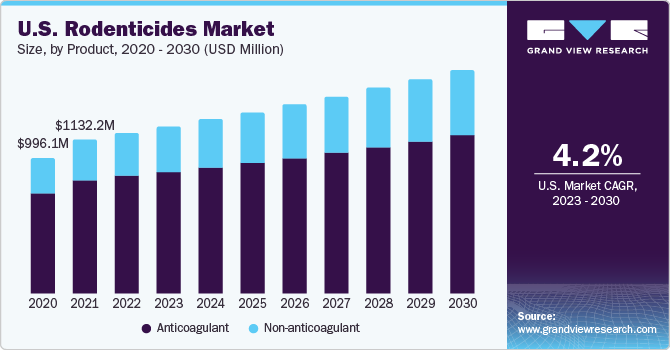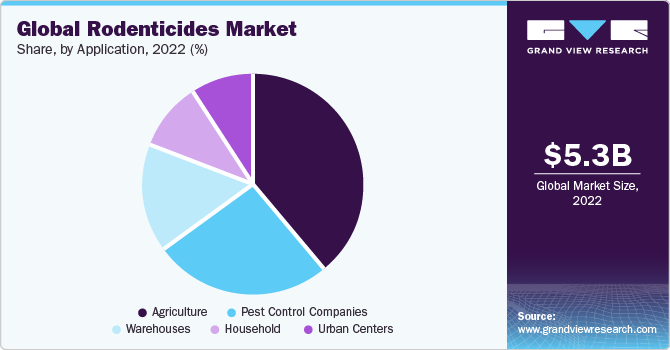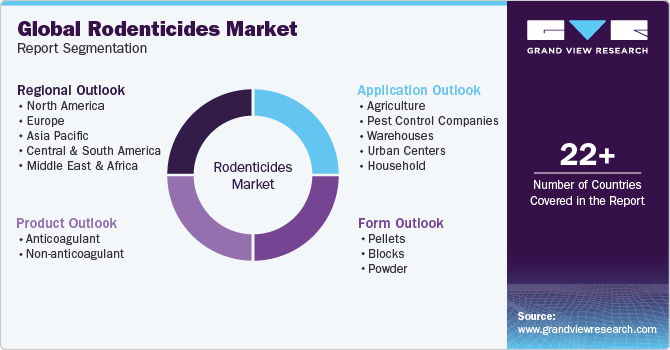
Rodenticides Market Size, Share & Trends Analysis Report By Product (Anticoagulant, Non-anticoagulant), By Form (Pellets, Blocks, Powder), By Application (Pest Control Companies, Warehouses, Household), By Region, And Segment Forecasts, 2023 - 2030
- Report ID: GVR-2-68038-499-4
- Number of Report Pages: 107
- Format: PDF, Horizon Databook
- Historical Range: 2018 - 2021
- Forecast Period: 2023 - 2030
- Industry: Bulk Chemicals
Rodenticides Market Size & Trends
The global rodenticides market size was valued at USD 5.27 billion in 2022 and is anticipated to grow at a compound annual growth rate (CAGR) of 5.6% from 2023 to 2030.Factors such as the increasing prevalence of pest-related diseases, a surging rodent population, rising demand for pest control, and the availability of natural rodenticides are likely to be major drivers of market growth. According to the 2019 American Housing Survey, among the 124 million occupied homes in the United States, 14.8 million reported seeing mice or rats inside the house over the course of a year.

Rising concerns regarding economic losses associated with damages caused by rodents in agricultural fields are likely to drive growth over the coming years. However, environmental concerns over the use of chemicals and their ill effects on humans and other living beings are likely to restrain demand. Therefore, product application is highly regulated by stringent laws. Regulations related to chemical rodenticide usage have been established in North America and Europe. For instance, all pesticide products must be registered under the U.S. EPA before being sold publicly. These products are regulated by the EPA under the Federal Insecticide, Fungicide, and Rodenticide Act (FIFRA).
Increasing rodent population is a major factor behind the growing prevalence of transferable diseases such as plague, Hantavirus infection, and Lassa fever, which affects the environment, wildlife, and human beings. This has triggered the use of rodent control products in commercial, residential, and industrial applications. These products are witnessing high demand in major cities globally. Companies are developing products to effectively control rodent population. The rising number of offices, hospitals, hotels, and housing, along with the high demand for hygiene, are expected to propel product demand.
Natural rodenticides are biodegradable and non-toxic to human, pets, and wildlife. They do not affect domestic animals or humans if consumed accidentally and they do not contaminate the environment. Moreover, such products are economically viable, as they do not require special storage, handling, transportation, and disposal.
Application Insights
The pest control companies segment accounted for the largest revenue share of 39.1% in 2022. Pest control companies provide services to hotels, home, retail business, apartments, office complex, food processing sector, manufacturing facilities, agriculture, warehouse, and electronic sectors. Mice and rats not only contaminate food but spread diseases. Increasing occurrences related to the damage of electric wirings and walls in commercial and residential buildings are likely to fuel demand for pest control services in the coming years.

The household segment is expected to advance at the fastest CAGR of 7.1% during the forecast period. A key factor driving the segment is the increasing urbanization and expansion of residential areas. As more people move into cities and towns, the likelihood of encountering rodent infestations in households also rises. Urban environments provide favorable conditions for rodents, including access to food sources and shelter. This leads to a higher demand for effective rodent control solutions, such as rodenticides, to protect households from potential health risks and property damage caused by them.
Growing awareness regarding the health risks associated with rodent infestations is also expected to drive this market. Rodents are known carriers of various diseases that can be transmitted through direct contact with rodents or their droppings, urine, or saliva. The potential health hazards posed by rodents create a strong incentive for homeowners to take preventive measures and use rodenticides to eliminate their population in households.
The agriculture segment accounted for a significant market share in 2022. Increased damage caused by rodents to stored grain, farm equipment, and field crops in the global agriculture sector is likely to drive demand over the forecast period. Rodents can potentially present the most serious threats to global food protection. Loss of food and crop has been witnessed in various countries over the past few years.
The warehouse segment is anticipated to advance at notable CAGR during the forecast period. Rodents take shelter under manmade structures such as warehouses to avoid temperature changes. They damage storage structures, stored products, and containers, which are anticipated to augment the use of rodenticides in warehouses over the forecast period. The increasing transmission of infectious diseases in urban areas is a major global concern. Growing urbanization has led to high demand for sanitation and hygiene from the population. These factors are likely to drive rodenticide demand in urban centers.
Product Insights
Rodenticides are classified into anticoagulant and non-anticoagulant, based on their application. Difethialone, bromadiolone, brodifacoum, chlorophacinone, and warfarin are anticoagulants, while bromethalin, cholecalciferol, strychnine, sodium fluoroacetate, and zinc phosphide are some of the chemical non-anticoagulant variants. These active ingredients are mixed with vegetable oil and grains and fed to rodents.
The anticoagulant segment accounted for a dominant revenue share of 76.9% in 2022. Anticoagulants cause internal bleeding, which can eventually lead to death due to blood loss. These products are further divided into first and second generation. First generation anticoagulants include diphacinone, warfarin, and chlorophacinone while second-generation anticoagulants include bromadiolone, difenacoum, difethialone, and brodifacoum.
First and second generation anticoagulants block a rodent’s ability to produce blood clotting factors, which ultimately kills them. First generation anticoagulants require more than one dose to show their effect. If any other animal consumes an anticoagulant meant for rodents, there is a chance of secondary killing. First generation anticoagulants are labeled for agricultural use for pocket gopher control, vole control, and below-ground mole.
The non-anticoagulant segment is expected to expand at the fastest CAGR of 6.4% during the forecast period in the global rodenticides market. Acute rodenticides have played a vital role in rodent control. Zinc phosphide is majorly used for field rodents in China. Anticoagulants are considered legal in the country. However, in recent years, farmers have been changing their preferences owing to their slow impact.
Form Insights
Rodenticides are generally available in pellets, blocks, and powder form. Use of rodenticides provides efficient and quick results in terms of destroying rodents, which is likely to propel their demand over the forecast period. However, strict government rules about the use of active ingredients are predicted to restrain market growth over the coming years.
The block segment held the largest revenue share of 46.0% in 2022. These are appropriate for outdoor use as they are waterproof and resistant to the environment. Use of this form by pest control companies is expected to fuel growth in the coming years. Meanwhile, the pellets segment is expected to expand at the fastest CAGR of 6.0% during the forecast period. Rodents consume almost everything, including grass, grains, seeds, plants, fruits, and scrap & waste. Rodenticide pellets attract a large number of rodents due to its seed-like shape, which, in turn, is likely to propel their demand over the coming years.
The powder segment accounted for a notable revenue share in 2022. The segment is likely to witness restrained growth in the coming years due to risks associated with the easy accessibility of the product to pets, humans, and wildlife. These products are not used in ventilation ducts as it can lead to the spread of particles into the air, which, in turn, can contaminate food and other sensitive products.
Regional Insights
Asia Pacific dominated the market with a revenue share of 29.8% in 2022 and is expected to expand at the fastest CAGR of 7.6% during the forecast period. Asia Pacific is a competitive market due to the presence of over 3,000 pest control companies. Unusual climatic conditions such as floods, heavy rainfall, and cyclones are major causes of rodent outbreaks in the region. Moreover, the availability of better than usual food supply in agricultural fields provides a more suitable breeding ground for rodents, which, in turn, increases their numbers. Such factors are anticipated to drive regional demand for effective pest control measures over the forecast period.

North America held a significant revenue share in 2022. The presence of a large number of manufacturers, coupled with high standards of hygiene, is likely to drive the demand for rodenticides in North America over the forecast period. Renovation and modernization activities in this region have resulted in the displacement of a large number of rats from old buildings, which then disperse into the city.
Europe is a major market for rodenticides and accounted for a notable revenue share in 2022. Rising rodent population in the region is expected to drive product demand over the forecast period. The market is highly fragmented in nature with the presence of over 6,000 pest control companies. Major reasons behind the rise in rodent population are the deteriorating conditions of drains and garbage in the region. Strict government regulations regarding pest control methods due to possibility of secondary kills are likely to restrain industry growth.
The Central & South America region is expected to advance at a significant CAGR during the forecast period. Countries in South America, such as Brazil and Colombia, are affected by wide-scale losses in agricultural crops that are majorly destroyed by rodents. Rodents are responsible for damage to crops, reduction in food production, and transmitting diseases. Such factors are expected to drive the growth of the regional industry in the coming years.
Key Companies & Market Share Insights
Acquisitions and new product developments are key strategies being adopted by manufacturers in order to strengthen their position in the market. Companies are trying to develop new application-specific products in an attempt to increase their market scope. Extensive R&D investments for the development of effective and high-quality products and technologies are also being undertaken by manufacturers.
Key Rodenticides Companies:
- BASF SE
- Bayer AG
- Rentokil Initial plc
- Neogen Corporation
- Bell Labs.
- Liphatech, Inc.
- Impex Europa S.L.
- EcoClear Products
Recent Developments
-
In April 2023, Target Specialty Products introduced Strike MAX CITO Paste, a commercial rodenticide paste known for its rapid action and user-friendly application. Engineered for both internal and external use, it functions as a soft bait paste, with its swift efficacy attributed to its primary component, brodifacoum
-
In January 2022, Syngenta Crop Protection AG successfully completed the acquisition of two advanced bio-insecticides, UniSpore and NemaTrident, from BIONEMA, a developer of biocontrol technology based in UK. This acquisition is intended to address a diverse array of insects and pests in ornamentals and horticulture, forestry, and turf amenity sectors, thus offering customers an expanded range of solutions
-
In June 2022, FGV Agri Services Sdn. Bhd. unveiled an environment-friendly rodenticide, the Butik S, tailored for paddy crops in Malaysia. As a contribution to the Paddy Production Incentive Scheme (SIPP), the pioneering rodenticide has been specially designed for cage owl integration. This anti-coagulant bait is formulated using a blend of substances that are enticing to rodents, and its shape, weight, and color are carefully crafted to attract rats effectively
-
In July 2021, Bayer AG, a member of the British Pest Control Association, introduced Harmonix Rodent Paste. This new cholecalciferol rodenticide, designed for professional use, can be applied in open spaces and burrows
-
In September 2021, Bell Labs launched a newly registered rodenticide named Contrac California Bromethalin. This bait is formulated with the active ingredient bromethalin, which is a single-feed component
-
In April 2018, BASF SE introduced a novel rodenticide named Selontra, highlighting its ability to eliminate rodent infestations within seven days. The active ingredient in the bait is cholecalciferol, a unique substance characterized by a distinct mode of action that rodents are not known to have developed resistance against yet
Rodenticides Market Report Scope
|
Report Attribute |
Details |
|
Market size value in 2023 |
USD 5.55 billion |
|
Revenue forecast in 2030 |
USD 8.13 billion |
|
Growth rate |
CAGR of 5.6% from 2023 to 2030 |
|
Base year for estimation |
2022 |
|
Historical data |
2018 - 2021 |
|
Forecast period |
2023 - 2030 |
|
Quantitative units |
Revenue in USD million and CAGR from 2023 to 2030 |
|
Report coverage |
Revenue forecast, company ranking, competitive landscape, growth factors, and trends |
|
Segments covered |
Product, form, application, region |
|
Regional scope |
North America; Europe; Asia Pacific; Central & South America; MEA |
|
Country scope |
U.S.; Canada; Mexico; UK; Germany; France; Italy; Spain; China; India; Japan; South Korea; Brazil; Argentina; Saudi Arabia; South Africa |
|
Key companies profiled |
BASF SE; Bayer AG; Rentokil Initial plc; Neogen Corporation; Bell Labs.; Liphatech, Inc.; Impex Europa S.L.; EcoClear Products |
|
Customization scope |
Free report customization (equivalent up to 8 analyst’s working days) with purchase. Addition or alteration to country, regional & segment scope |
|
Pricing and purchase options |
Avail customized purchase options to meet your exact research needs. Explore purchase options |
Global Rodenticides Market Report Segmentation
This report forecasts revenue growth at the global, regional, and country levels and provides an analysis of the latest industry trends in each of the sub-segments from 2018 to 2030. For the purpose of this study, Grand View Research has segmented the global rodenticides market report on the basis of product, form, application, and region:

-
Product Outlook (Revenue, USD Million, 2018 - 2030)
-
Anticoagulant
-
Non-anticoagulant
-
-
Form Outlook (Revenue, USD Million, 2018 - 2030)
-
Pellets
-
Blocks
-
Powder
-
-
Application Outlook (Revenue, USD Million, 2018 - 2030)
-
Agriculture
-
Pest Control Companies
-
Warehouses
-
Urban Centers
-
Household
-
-
Regional Outlook (Revenue, USD Million, 2018 - 2030)
-
North America
-
U.S.
-
Canada
-
Mexico
-
-
Europe
-
Germany
-
UK
-
France
-
Italy
-
Spain
-
-
Asia Pacific
-
China
-
India
-
Japan
-
South Korea
-
-
Central & South America
-
Brazil
-
Argentina
-
-
Middle East and Africa
-
Saudi Arabia
-
South Africa
-
-
Frequently Asked Questions About This Report
b. The global rodenticides market size was estimated at USD 5.27 billion in 2022 and is expected to reach USD 5.55 billion in 2023.
b. The global rodenticides market is expected to grow at a compound annual growth rate of 5.6% from 2023 to 2030 to reach USD 8.13 billion by 2030.
b. Asia Pacific dominated the rodenticides market with a share of 29.9% in 2022. This is attributable to rising rodent population in the region and supportive government regulations regarding pest control methods to avoid secondary kill.
b. Some key players operating in the rodenticides market include BASF; Bayer AG; Rentokil Initial PLC; Neogen Corporation; Bell Laboratories Inc.; Liphatech Inc.; and Impex Europa.
b. Key factors that are driving the market growth include increased prevalence of pest-related diseases, surging rodent population, and rising awareness regarding pest control.
We are committed towards customer satisfaction, and quality service.
"The quality of research they have done for us has been excellent."




